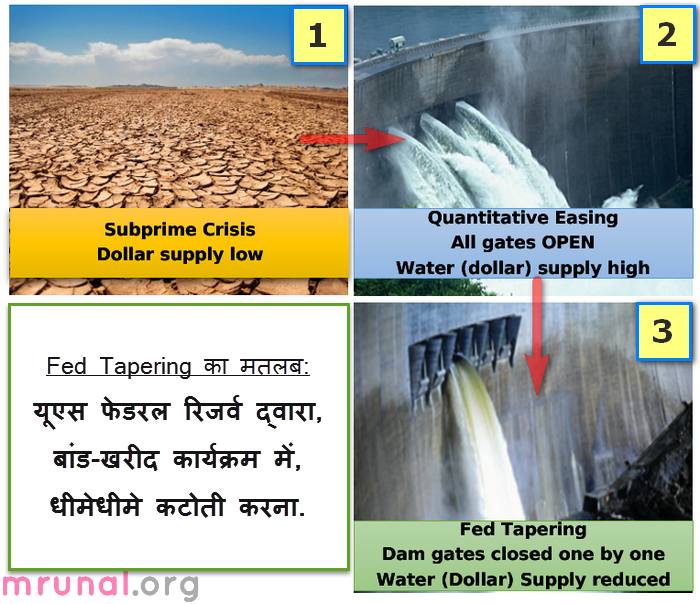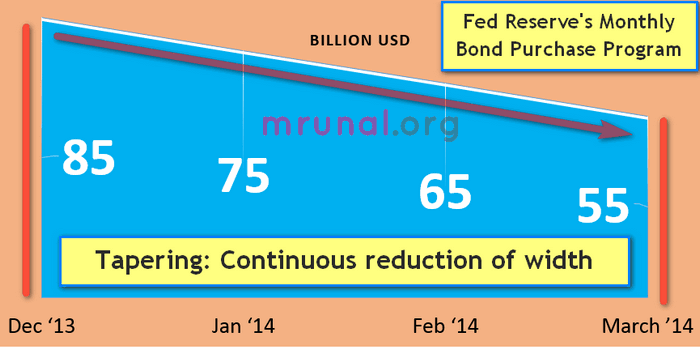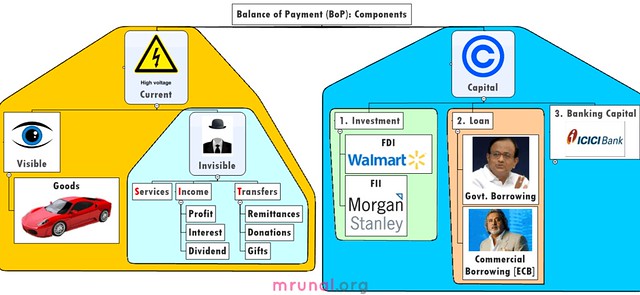- Prologue
- What is Fed tapering
- Why is it called Fed Tapering?
- How can Fed Tapering affect India?
- Worst case scenario [WCS] by Fed Tapering
- BoP crisis: How can that happen?
- Can Fed Tapering “really” cause BoP crisis?
Prologue
- you already know about Quantitative easing and its impact on Indian economy. Click me. So far we know that:
- in this article, we’ll learn the basics of Fed tapering and its (possible) negative impacts on Indian Economy.
- in the next article= Steps taken by RBI +Government to immunize Indian economy against the negative impacts of Fed Tapering (currency swap agreements etc.) click me
What is Fed tapering
In the first article, we saw that:
Subprime crisis:
- Investors money stuck in mortgage backed securities and other toxic assets.
- You may visualize this as a “Draught” of dollars.
Quantitative Easing
- American RBI (US Feds) launched a program to buy toxic assets and government securities from market.
- Result? Dollar supply increased. (Because central bank is buying stuff from someone and paying them in dollars.)
- You may visualize this as American RBI opened all gates of the dam to send maximum quantity of water (dollars) to American farmers. Although lot of that water- went to Chinese and Indian farmers as well!
- QE was carried out in three phases. Finally in Dec 2012, Chairman Ben Bernanke announced that he’ll stop this water-supply when EITHER unemployment rate is <6.5% OR inflation is >2.5%. Because each condition implies that American farmers are booming, hence no need to give them lot of irrigation water (dollars) under Rajiv Gandhi Sinchaai yojana Quantitative Easing.
- Dec 2013: Finally Chairman Ben Bernanke sees American farms are booming, there is no need to release lot of water from dam (dollar supply). [in reality – unemployment rate became lower than 6.5%]
- So, he starts closing dam-gates one after another. Result? water supply (dollar) reduced. This is fed tapering. Observe
| Time | Bond Buying Program (Billion USD) |
| Dec 2013 | 85 |
| Jan 2014 | 75 |
| Feb 2014 | 65 |
| March 2014 | 55 |
At this rate, canal doors should completely shut down @October 2014. (Because now the new Chairman Jenet Yellen is reducing the water supply (dollars) by 10 billion USD per month.)
Why is it called Fed Tapering?
- In above graph, observe that the “Width” of canal / graph is decreasing constantly. (in other words, Dollar supply is decreasing).
- “Tapering” is a mechanical term, to describe such constant decrease in width.
- And since this is being done by US Federal Reserve, so we call it “Fed Tapering”.
- Formal definition: Fed tapering is the gradual reduction in the bond buying program of the US Federal Reserves.
How can Fed Tapering affect India?
- From Mexican drugloards to Hongkong smugglers to Russian arms dealers to Italian Mafias to Indian Bookies n Match fixers- everyone uses dollars. So any increase OR decrease in dollar supply affects all economies.
- In last article, we saw the effect of Quantitative Easing (=increased dollar supply) on Indian Economy.
Let me summarize that in a table:
| Indian point of view | Dollar Supply | FDI-FII | ExchangeRate | Export |
| Quant. Easing | HIGH | Increase | Rs. becomes Strong
| Down due to Subprime + Greece/Eurozone crisis. |
Since QE = increase dollar supply and Fed tapering= decrease in dollar supply, so by common sense, every effect should become reverse, right?
| Indian point of view | Dollar Supply | FDI-FII | ExchangeRate | Export |
| Quant. Easing | HIGH | Increase | Rs. Becomes Strong
| Down due toSubprime + Greece/Eurozone crisis. |
| Fed Tapering | Medium | Decrease | Rs. Becomes Weak
| Not as high as expected. (more given in later paragraphs) |
Let’s not waste more time in ball by ball commentary and jump directly to:
Worst case scenario [WCS] by Fed Tapering
- Every once in a while, Rajan and Chindu make press statements that Indian economy is strong enough to survive the negative effects of Fed tapering.
- Meaning, atleast one expert in the whole world -believes that Indian economy is bogus and we’ll be thoroughly devastated by Fed Tapering. (otherwise Rajan/Chindu did not have to keep giving such explanations to media.)
- So let’s check the possible worst case scenarios. How can Fed tapering hurt Indian economy?
WCS1: Hot money gone / Flight of Capital
- FIIs takeout their money from India to reinvest in USA (Because Fed tapering implies that US economy is recovering. So, American investors may want to re-invest in USA.)
Result?
- Sharemarket may go down (may even crash- if there is largescale exit of FIIs)=> desi investors’ money lost.
- Rupee will weaken further. How?
Suppose an American FII (say Morgan Stanley) invested in Reliance infra.shares. But now he wants to exit.
- Morgan sells those shares= get gets paid in rupees
- But he wants to re-invest money in USA = he needs dollars. Not rupees. Therefore, he’ll sell those “rupees” to get dollars (onion).
| Supply of onion (dollars) | Decreased because of fed tapering. (recall those dam gates are being closed one by one) |
| Demand of onion (dollars) | Increased because FII is exiting from Indian market. |
| Result? | Onion (dollar) gets more expensive. $1=65=>$1=70….. In other words, dollar strengthens and rupee weakens. |
WCS2: Weaker Rupee= bigger CAD + bigger inflation
- FII gone = Rupee weakens
- While weak rupee = good news for Exporters. But bad news for importers.
- Weaker rupee = we’ve to pay more amount of rupees, to get same amount of crude oil = Current Account deficit (CAD) gets Higher. Rupee weakens further.
- As crude oil gets more expensive =petrol diesel gets more expensive= transport charges increase= milk, veggies everything gets more expensive. (Including raw material.)
- Raw material gets expensive= input cost of exporters increased = they cannot fully take advantage of the new demand created by USA customers/US importers.
WCS3: Exports may not increase
Fed tapering = US feds has started decreasing water supply (dollar) from their canal (Bond-buying program). This implies that USA economy is recovering. So, If US economy is recovering = American juntaa will buy more = Indian exporters will see more demand. (This is the positive thinking assumption.) but there are two errors in this positive thinking.
- Weak rupee = expensive crude oil =Cost of raw material increases. Hence our export prices may not get that competitive yet, (compared to China, Thailand etc.)
- Dushmani 4 DEVYANI (Explained below)
Dushmani 4DEVYANI= less EXPORTs
- American MNCs love India only as long as we are their call center guys and allow them to open malls and e-commerce sites in India.
- But as soon as our companies compete in their hometurf @USA, these American MNCs will use every trick in the book to prevent “our” entry.
- Indian government mishandled Devyani case- annoyed the Obama administration, creating some bitterness in relations.
- Now, American business lobbyists are using this negative-sentiment to get American regulatory bodies to teach us a “lesson” and get tit-for-tat. Observe:
| US body | “Lesson” taught to Indians during Feb 2014 |
| USFAA | Federal Aviation administration. In Feb 2014, They reduced India’s airline safety ratings from level I to level II.
Consequences: Indian aviation will not bring *that much* dollars as expected.
|
| USFDA | They’ve Have cancelled licenses of Ranbaxy’s Punjab and Gujarat factories.Feb 2014: USFDA commissioner came to India to inspect our pharma companies. USFDA’s “activism” = hurts our pharma companies, negative publicity = less export orders (From US customers, as well as EU, Japan- everwhere.)= less export = higher CAD. |
| USTR | United States Trade Representative. They lodged complaint against India, for giving solar subsidies to desi companies. (Since Indian government gives subsides to local companies under national solar mission program= American solar systems automatically become expensive in India= cannot compete. Thus India is violating the “non-tariff” barriers principle of WTO. |
| USITC | Given below |
US International Trade Commission (USITC)
- It is a quasi-judicial body.
- US government uses their report to decide trade policy.
- Hence, if USITC writes negative report about India, then we’ll suffer indirectly in future (if Obama imposes tariff and non-tariff barriers on Indian goods and services).
At present USITC is conducting a hearing about “How Indian trade policies affect US jobs”.
Special 301 report & Priority status= less EXPORTs
- United States Trade Representative (USTR) writes this report.
- Deals with IPR (intellectual property rights) related matters.
- US government also uses this report to decide future trade policy.
- Experts believe, India will also get negative review in this 301 report. Because Indian authorities have hurt the IP-interests of Pharma MNCs. For example
| Novartis | SC rejected patent claim over their blood cancer drug (Glivec) |
| Bayer’s pharma | Indian Patent office allowed NATCO to product the same blood cancer drug (NEXAVAR). |
- If we get negative review in Special 301 report = USTR can classify India as “Priority foreign country”
- Priority tag sounds “VIP” right? Nope infact it is bad news.
- Because USTR has powers to penalize “priority” countries e.g they can to impose higher duty/taxes and quota restrictions on Indian exports to USA. (and WTO may not help India in this case.)
- Since USA accounts for ~12% Indian exports. So imagine the negative consequences on Balance of Trade (Because export will decline).
Ofcourse, one can argue that Indian drugs are bad quality or that Indian IPR/Patent law sucks. Therefore, USA’s actions are justified. But we are the same country since last three years- yet until now American regulatory bodies did not take any action. BUT ONLY after Devyani case and within just one month (February 2014) , they suddenly start all this “regulatory activism”=> something fishy, revenge mindset, will hurt Indian exporters.
BoP crisis: how can that happen?
In the worst-of-the-worst-case scenario, Fed tapering may cause Balance of Payment (BoP) crisis in India. How?
First let’s understand some background theory: when and how can BoP crisis happen?
- Balance of Payment is a systematic record of all economic transactions between residents and non-residents of a country.
- BoP is divided into two parts. Current vs Capital. (and “incoming” vs “outgoing” money in each of them). click on following chart.
In each of them, further we’ve incoming money (credit) and outgoing money (Debit).
For the sake of understanding, let’s observe a BoP data from 2012-13 (USD million dollars).
[Table] BoP Current Account [2012-13]
| Current Account, Million dollars | Credit + | Debit - | Net | |
| Visible | Goods | 300000 | 500000 | -200000 |
| Invisible | services | 150000 | 80000 | +70000 |
| Income (Profit, Interest, Dividend) | 10000 | 30000 | -20000 | |
| Transfers (Remittance) | 68000 | 4000 | +64000 | |
| Balance of Current Account | 528000 | 614000 | -88,000 | |
In other words, we had Current Account deficit of 88 billion $ in 2012-13.
[Table] BoP: Capital account
| capital account | Credit + | Debit - | Net | |
| investment | FDI | 215000 | 170000 | 45000 |
| FII | 175000 | 150000 | 25000 | |
| Borrowing | Government +private | 150000 | 120000 | 30000 |
| Bank Capital | Non-resident bank accounts | 83000 | 67000 | 16000 |
| Total Capital acct. | +89300 | |||
In otherwords, we had Current account surplus of ~90 billion $ in 2012-13. Now let’s do total
| 2012-13 | Million USD |
| Current | -88000 |
| Capital | +89300 |
| Error Omission | +2689 |
| Overall | +4000 (Approx.) |
What happens to this “overall” surplus 4 billion USD? Three things can happen
| Then +4 billion USD = more “supply” of onions (dollarS) in the Desi Forex market. This will change in rupee-dollar exchange rate, because of laws of supply n demand. |
| Balance of payment will become zero. |
| Same as above. |
We took the third option. Observe.
| 2012-13 | Million USD |
| A.Current account | -88000 |
| B.Capital account | 89300 |
| C.Error Omission | 2689 |
| Overall (from A+B+C) | +4000 (Approx.) |
| Overall surplus sent to RBI’s forex reserve | -4000 |
| Balance of Payment | 0 |
Meaning, as long as Capital account has more money than Current account, we’ll have surplus.
But what happens IF we don’t have surplus (i.e. capital account has less money than current account)?
It happened in 1991′s BoP crisis. Observe the data
| 1991 (Apr-Sep) | Million $$ |
| Current | -6634 |
| Capital | +4808 |
| Overall Balance | -1826 |
- In above table, We don’t have any surplus! See we had deficit of ~2 billion USD. (=pothole is created).
- IF we want to get final Balance of payment “ZERO” then someone (Rajan, Mohan, Chindu, Rajesh Khanna or Shakti Kapoor) must pour in +2 billion US dollars to fillup this pothole.
- But in the 1991, RBI did not have sufficient forex reserve to fillup this pothole with dollars. (RBI had barely ~730 million USD, while pothole was ~2 billion).
If this pothole is not filled up, then what will happen?
- Extreme shortage of onions (dollars) in Indian forex market. => price of 1 onion(dollar) will go as high as 500 Rupees or even more!
- Then, We won’t have dollars to pay for our crude oil imports= economy collapses.
This is called Balance of Payment (BoP) crisis. Solution? We had to pledge ~65 tonnes of gold to IMF to borrow ~2.3 billion USD. That money was used to fillup the BoP pothole. We also initiated LPG reforms, to ensure that in future we have sufficient capital surplus so BoP crisis doesn’t happen again. Enough flashback of ’91, Back to original moving:
Can Fed Tapering *REALLY* cause BoP crisis?
There are three pre-conditions for BoP crisis to happen:
- Huge current account deficit. (i.e. lot money outgoing in crude oil / gold / xyz imports while exports don’t bring enough dollars)
- Capital account surplus is not big enough to fill that Current Account deficit. (i.e. less money coming via FDI, FII, ECB, NRI-bank deposits.)
- RBI doesn’t have enough forex reserve to fill up the pothole created by #2 MINUS #1.
| Preconditions 4BoP Crisis? | Worst case scenario under Fed Tapering | Precondition met? |
| #1: Huge current account deficit |
| Yes, definitely |
| #2: Capital inflow not big enough. |
| Yes, may be |
| #3: RBI doesn’t have forex reserve. | Not correct. RBI has sufficient backup
= total atleast 450 billion USD backup. (more details after few paras.)
| Hell NO! |
Meaning,
- Fed Tapering unlikely to cause BoP Crisis v2.0 in India
- because THIRD pre-condition is not met. (And that’s because RBI DOES have large forex reserve + backup to fillup the pothole.)
Nonetheless, prevention is better than cure. In the next article, we’ll see the steps taken by RBI +Government ot immunize Indian economy against the negative impact of Fed Tapering.
Courtesy: Mr.Shivaram G. for inputs.
Visit Mrunal.org/Economy For more on Money, Banking, Finance, Taxation and Economy.




No comments:
Post a Comment
Note: Only a member of this blog may post a comment.